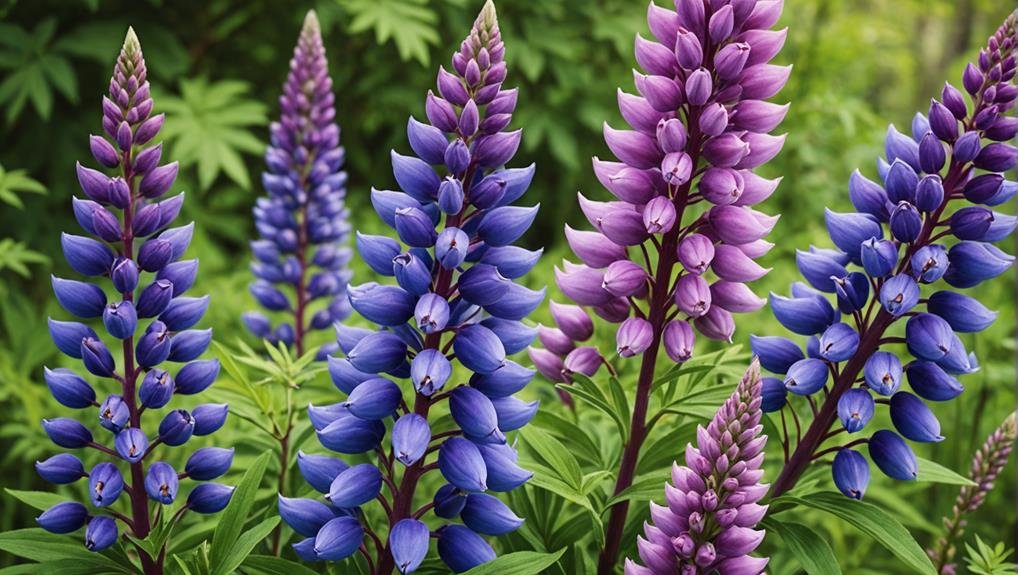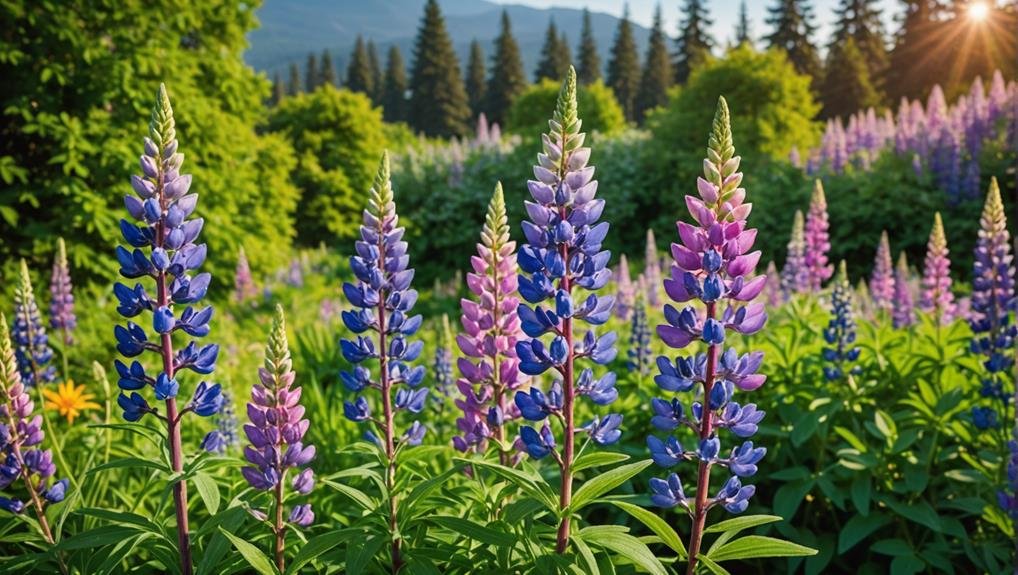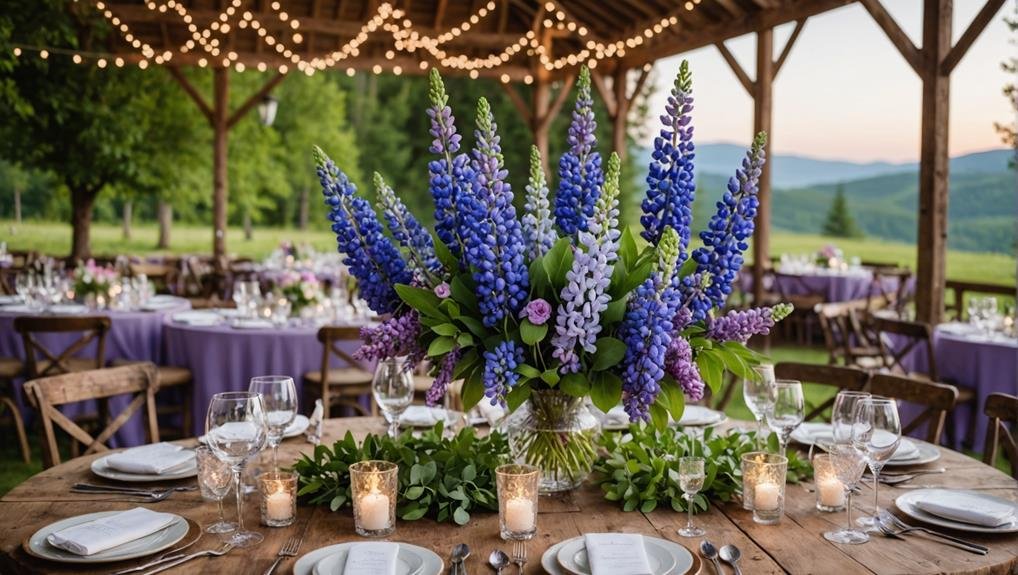Lupines, with their striking hood-shaped blooms and diverse color palette, offer an exquisite choice for wedding floral arrangements. These flowers, which are available in wholesale markets in convenient wraps of 10 stems, not only enhance the aesthetic appeal but also embody symbolism such as happiness and creativity. Ideal for summer and outdoor weddings, Lupines bring a sense of vibrancy and elegance to bouquets and centerpieces. As we explore the various aspects of this versatile flower, one might wonder how its unique characteristics could perfectly align with your wedding theme.
Flower Overview

Lupines, also known as Bluebonnets and Quaker Bonnets, are a member of the Fabaceae family, distinguished by their hood-shaped flowers and distinctive petal structure. These flowers are particularly notable for their unique beauty and versatility, making them a popular choice for wedding arrangements. The flowers range from 1 to 2 centimeters in length and present a central stem with an upper petal and two lateral petals fused as a 'keel.'
Cut lupines are typically available in wholesale flower markets for a few months each year, sold in wraps of 10 stems. This availability makes them an attractive option for floral designers and event planners looking to create stunning, short-term arrangements. Due to their relatively short vase life, lupines are best suited for same-day use, such as on a wedding day, where their vibrant presence can be fully appreciated without concern for longevity.
For those planning a wedding or special event, lupines can be conveniently purchased online in bulk. This allows for a selection of fresh, high-quality flowers perfect for crafting memorable wedding bouquets and centerpieces, ensuring that every detail of the floral decor is impeccable.
Physical Description
Renowned for their striking visual appeal, these flowers exhibit a hood-shaped bloom structure that measures between 1 and 2 centimeters in length. Lupines, also known as Bluebonnets and Quaker Bonnets, belong to the Genus of the Fabaceae Family. The blooms are arranged on a central stem, creating a visually captivating floral display that is particularly popular in wedding arrangements.
In terms of size and shape, lupines possess a unique flower structure characterized by one upper petal and two lateral petals that are fused to form a 'keel.' This distinctive configuration sets them apart from many other floral species, contributing to their unique characteristics. The central stem, adorned with these intricate flowers, can reach significant heights, adding vertical interest to floral compositions.
Color variations in lupines are diverse, offering a range of hues that can complement various wedding color schemes. While specific color varieties will be discussed in the subsequent section, it is worth noting that these flowers can be found in an array of shades, providing ample options for customization. Cut lupines are typically sold in wraps of 10 stems and are available in wholesale flower markets for a few months annually, making them a seasonal yet stunning choice for any wedding.
Available Colour Varieties

A stunning array of colors is available when selecting lupines for wedding arrangements, ranging from deep blues to vibrant yellows. Lupines offer a diverse palette that includes shades of blue, purple, pink, red, white, and yellow, catering to an extensive range of color preferences.
Popular varieties such as Gallery Blue, Gallery Red, and Gallery Yellow provide vibrant options that can enhance any wedding theme.
The versatility of lupines extends further with their bi-color combinations, which add a unique and eye-catching element to bouquets and centerpieces. These bi-color varieties can create striking contrasts, making each arrangement visually enthralling.
This wide range of colors allows for creative bouquet options, whether the lupines are used as a focal point or as part of a mixed floral arrangement.
Lupines' diverse color palette ensures they can seamlessly complement various wedding themes and color schemes. Their ability to blend with other flowers or stand out on their own makes them an excellent choice for different floral arrangements.
Latin Name and Taxonomy
Belonging to the Genus Lupinus within the Fabaceae family, the lupine's taxonomy underscores its place among the leguminous plants known for their vibrant floral displays and beneficial nitrogen-fixing capabilities. This taxonomic classification places lupines among a diverse group of flowering plants that are not only visually appealing but also environmentally beneficial due to their ability to improve soil fertility.
The scientific name for these plants is derived from their genus, Lupinus. Lupines are commonly referred to by several common names, including Bluebonnets and Quaker Bonnets, reflecting their widespread appeal and distinctive hood-shaped flowers. These flowers, measuring 1-2 cm in length, are arranged on a central stem and exhibit a unique structure with one upper petal and two lateral petals fused together to form a 'keel.'
Understanding the taxonomic classification of lupines is essential for horticulturists and florists alike, as it provides insights into their growth habits and ecological benefits. By recognizing lupines as members of the Genus Lupinus, professionals can better appreciate their role in garden ecosystems, particularly their nitrogen-fixing ability, which enhances the growth of neighboring plants. This knowledge is invaluable for incorporating lupines into wedding arrangements and other floral designs.
Geographical Origins

Originating from North and South America, lupines exhibit a remarkable adaptability to diverse environmental conditions across these continents. These native plant species are commonly found in meadows, woodlands, and open areas, thriving particularly well in well-drained, sandy soils. This broad distribution highlights the ecological impact lupines have on their habitats, contributing to soil stabilization and providing food sources for various pollinators.
Lupines have also been introduced beyond their native range to regions such as Europe, Australia, and New Zealand. These introductions have sometimes resulted in unforeseen ecological impacts, both positive and negative, on local ecosystems. For instance, while they add aesthetic value and biological diversity, they can also outcompete native flora, necessitating targeted conservation efforts to maintain ecological balance.
To further understand the geographical origins and spread of lupines, consider the following points:
- Ecological Impact: Lupines improve soil health through nitrogen fixation but can become invasive in non-native regions.
- Conservation Efforts: Initiatives are in place to manage lupine populations, ensuring they do not disrupt local ecosystems.
- Native Plant Species: As native flora, lupines play an essential role in their original habitats, supporting biodiversity and ecosystem services.
Understanding the geographical origins of lupines provides valuable insight into their role within various ecosystems and underscores the importance of responsible cultivation and conservation practices.
Season Availability
Lupines are mainly available in wholesale flower markets during the spring and early summer months. This seasonal availability aligns perfectly with the peak wedding season, making lupines an attractive choice for bridal bouquets and floral arrangements. The lupine popularity during these months is attributed to its vibrant colors and elegant appearance, which can greatly enhance the aesthetic appeal of any wedding event.
When considering lupines for your wedding, it is essential to note their pricing and availability. Typically sold in wraps of 10 stems, lupines offer a cost-effective option for bulk purchases. However, due to their relatively short vase life, they are best utilized on the same day they are cut, ensuring their freshness and visual appeal. This characteristic makes lupines ideal for weddings and events that require day-of preparations.
Lupine bouquet ideas abound, owing to their moderate height of 70/80cm, which allows for versatile floral designs. They can be combined with other seasonal flowers to create stunning, eye-catching arrangements. Despite their delicate nature, when used properly, lupines can provide a unique and memorable floral touch to any wedding celebration.
Growing Conditions

Best growing conditions for lupines require full sunlight to partial shade, well-drained soil, and a slightly acidic to neutral pH level. These elements are essential for optimal growth and vibrant blooms. Lupines are adaptable to varying soil requirements but perform best in sandy or loamy soils that facilitate adequate drainage. Sun exposure is also crucial; while they can tolerate partial shade, full sunlight promotes more robust flowering.
Lupines are relatively low-maintenance when it comes to watering needs. Once established, they are drought-tolerant and do not require frequent watering. This characteristic makes them ideal for gardens with limited water availability. Additionally, lupines exhibit impressive cold resilience, thriving in USDA zones 4-8. Some varieties can even withstand colder temperatures, making them suitable for various climates.
For successful cultivation, consider these points:
- Soil and Sun Exposure: Ensure well-drained, slightly acidic to neutral soil and provide full sunlight to partial shade.
- Watering and Cold Resilience: Water sparingly once established and be mindful of their ability to tolerate cold climates.
- Seed Propagation and Transplanting Tips: Lupines can be grown from seeds or transplants. Seeds benefit from scarification before planting, and careful transplanting ensures healthy root development.
These guidelines will help you cultivate beautiful lupines for any event decoration.
Cultural Significance
Embracing rich cultural symbolism, lupines are cherished in various regions for embodying happiness, imagination, and creativity, particularly in wedding bouquets. The symbolic meanings associated with lupines extend beyond their aesthetic appeal; they are believed to bring good luck and prosperity to newlyweds. This makes them a popular choice for wedding floral arrangements, where their presence is thought to enhance the joyful and auspicious nature of the celebration.
Traditional beliefs surrounding lupines further enhance their appeal in wedding contexts. In some cultures, these flowers are considered harbingers of positive energy and are used to symbolize love, admiration, and positivity. The vibrant colors and unique shape of lupine flowers contribute to their cultural associations with essential and uniqueness, making them a meaningful addition to any wedding ceremony.
Cultural associations with lupines also highlight their versatility in floral designs. Their ability to be incorporated into various arrangements allows for creative expression and personalization in wedding decor. This adaptability enhances the overall aesthetic, ensuring that the floral display is not only visually striking but also infused with significant cultural and symbolic meanings that resonate with the couple's unique journey.
Typical Use in Weddings

In wedding ceremonies, lupines are typically utilized to enhance bouquets, centerpieces, and various floral arrangements with their rustic and wildflower charm. Their vibrant colors and unique shape make them a popular choice for summer and outdoor weddings. The versatility of lupines allows them to complement a range of wedding themes and color schemes, adding a touch of natural beauty to the celebrations.
Lupine floral arrangements can be tailored to suit different styles, from whimsical to romantic. By incorporating lupines, couples can achieve a distinctively charming and wildflower look that enhances the overall wedding decor. Here are some typical uses of lupines in weddings:
- Lupine Bouquets: Often used as the focal point of bridal bouquets, lupines add a splash of color and texture, creating a striking and memorable arrangement.
- Lupine Centerpieces: These can be used to bring a rustic charm to wedding tables, perfectly complementing an outdoor or garden wedding theme.
- Lupine Floral Arrangements: Whether mixed with other flowers or showcased on their own, lupines can be used in various arrangements to create a cohesive and enchanting look.
Incorporating lupines into wedding decor not only highlights their natural beauty but also enhances the overall aesthetic of the event.
Alternative Flower Types
While lupines bring a distinct wildflower charm to wedding decor, there are several alternative flowers that can offer similar aesthetic qualities and versatility. Consider using delphiniums, irises, or larkspur as floral alternatives in your wedding arrangements. These flowers share similar tall, spiky shapes and vibrant colors, making them excellent choices for those seeking design inspiration.
Delphiniums, for instance, come in shades of blue, purple, and white, adding a cool and calming effect to your floral displays.
Irises, known for their striking beauty, offer a range of colors including blue, yellow, and white, allowing for diverse bouquet variations.
Larkspur, with its delicate and airy blooms, provides a soft and romantic touch to any centerpiece or bouquet. Available in shades of pink, purple, and white, larkspur can seamlessly blend into various wedding color schemes.
Experimenting with these alternative flowers can add variety and uniqueness to your wedding floral arrangements. By integrating delphiniums, irises, and larkspur, you can achieve a dynamic and visually appealing array of floral designs. These alternatives not only complement the aesthetic qualities of lupines but also enhance the overall beauty of your wedding decor.
